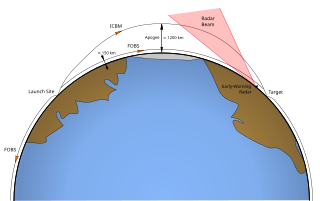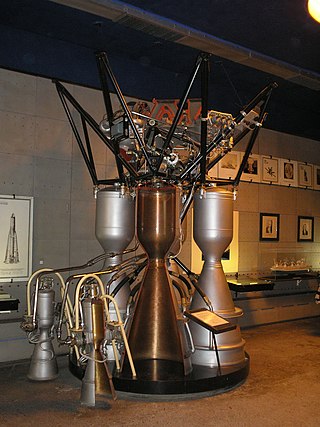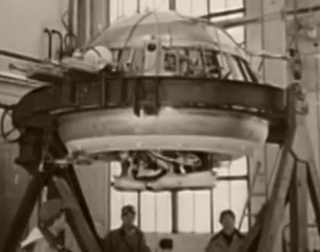Related Research Articles

A Fractional Orbital Bombardment System (FOBS) is a warhead delivery system that uses a low Earth orbit towards its target destination. Just before reaching the target, it deorbits through a retrograde engine burn.
The UR-200 was an intercontinental ballistic missile (ICBM) developed by Vladimir Chelomey's OKB-52 in the Soviet Union. It was known during the Cold War by the NATO reporting name SS-10 Scrag and internally by the GRAU index 8K81. The design was authorized by the Decisions of the Central Committee of the CPSU of March 16 and August 1, 1961, and the draft project was finished in July 1962. It first flew on November 4, 1963, from the Baikonur Cosmodrome. The ninth and final flight was conducted on October 20, 1964.

The RD-8 is a Soviet / Ukrainian liquid propellant rocket engine burning LOX and RG-1 in an oxidizer rich staged combustion cycle. It has a four combustion chambers that provide thrust vector control by gimbaling each of the nozzles in a single axis ±33°. It was designed in Dnipropetrovsk by the Yuzhnoye Design Bureau as the vernier thruster of the Zenit second stage. As such, it has always been paired with the RD-120 engine for main propulsion.

The RD-107 and its sibling, the RD-108, are a type of rocket engine used on the R-7 rocket family. RD-107 engines are used in each booster and the RD-108 is used in the central core. The engines have four main combustion chambers and either two (RD-107) or four (RD-108) vernier chambers.
The RD-120 is a liquid upper stage rocket engine burning RG-1 and LOX in an oxidizer rich staged combustion cycle with an O/F ratio of 2.6. It is used in the second stage of the Zenit family of launch vehicles. It has a single, fixed combustion chamber and thus on the Zenit it is paired with the RD-8 vernier engine. The engine was developed from 1976 to 1985 by NPO Energomash with V.P. Radovsky leading the development. It is manufactured by, among others, Yuzhmash in Ukraine.
The RD-843 is a Ukrainian single nozzle liquid propellant rocket engine. It burns a hypergolic mixture of unsymmetrical dimethylhydrazine (UDMH) fuel with dinitrogen tetroxide (N2O4) oxidizer. It is pressure-fed. It is rated for up to 5 restarts, and can gimbal up to 10 degrees in each direction.

The RD-0110 is a rocket engine burning liquid oxygen and kerosene in a gas generator combustion cycle. It has four fixed nozzles and the output of the gas generator is directed to four secondary vernier nozzles to provide attitude control for the stage. It has an extensive flight history with its initial versions having flown more than 64 years ago.
The RD-0214 (Russian: Ракетный Двигатель-0214 [РД-0214], romanized: Raketnyy Dvigatel-0214, lit. 'Rocket Engine 0214', GRAU index: 8D811) is a vernier thruster rocket engine burning unsymmetrical dimethylhydrazine (UDMH) fuel with dinitrogen tetroxide (N2O4) oxidizer in a gas-generator cycle. It has four nozzles that can each gimbal 45 degrees in plane to provide thrust vectoring control to the RD-0212 propulsion module of Proton rocket's third stage. It is a revised version of the RD-0207 (Russian: РД-0214, GRAU index: 8D67).

The RD-0210 (Russian: Ракетный Двигатель-0210, romanized: Raketnyy Dvigatel-0210, lit. 'Rocket Engine 0210', GRAU index: 8D411K) is also known as the RD-465. It and its twin, the RD-0211, are rocket engines using unsymmetrical dimethylhydrazine (UDMH) as fuel and dinitrogen tetroxide (N2O4) as oxidizer in an oxidizer rich staged combustion cycle. They have a single nozzle, possess thrust vectoring and are the latest evolution in the RD-0203/4 lineage. They are the engines used on the Proton second stage. The RD-0213 is a fixed nozzle variation that is used on the RD-0212 module of the Proton third stage.
The RD-0236 is a vernier thruster engine for liquid-fueled rockets. It burns a hypergolic mixture of unsymmetrical dimethylhydrazine (UDMH) fuel with dinitrogen tetroxide oxidizer in a gas generator cycle. It is used along the RD-0235 main engine on the UTTKh second stage, which was featured in the UR-100N ICBM as well as the Strela and Rokot launch vehicles derived from it. Its function is to supply thrust vector control by gimbaling each of its four nozzles in a plane. While the engine is out of production, the ICBM as well as Strela remain operational as of 2015. The Rokot launch vehicle conducted its final launch before retirement in December 2019.
The RD-263 is a liquid-fuel rocket engine, burning a hypergolic mixture of unsymmetrical dimethylhydrazine (UDMH) fuel with dinitrogen tetroxide oxidizer in the oxidizer rich staged combustion cycle. Four RD-263 engines form a propulsion module RD-264. For the R-36M KB Yuzhnoye only ordered the first stage propulsion to Energomash, instead of both stages, arguing that they were overworked with the RD-270 development. By April 1970 Yuzhnoye was getting the engine documentation. By the end of 1972 Energomash started to test fire the engines in its own test stand. And by September 1973 the engine was certified for flight. While the engine is out of production, the ICBM as well as the Dnepr remain operational as of 2015.
The RD-810 (РД-810) is a Ukrainian liquid propellant rocket engine burning LOX and Kerosene (RG-1) in a staged combustion cycle. It has a single combustion chamber that provides thrust vector control by gimbaling of the nozzle in two axis by +/- 8°. It is being designed in Ukraine by Yuzhnoye Design Bureau for the prospective first stage propulsion of the Mayak rocket family.

The RD-250 is the base version of a dual-nozzle family of liquid-fuel rocket engines, burning a hypergolic mixture of unsymmetrical dimethylhydrazine (UDMH) fuel with dinitrogen tetroxide oxidizer in an gas-generator open cycle. The RD-250 was developed by OKB-456 for Yangel's PA Yuzhmash ICBM, the R-36 (8K67). Its variations were also used on the Tsyklon-2 and Tsyklon-3 launch vehicles. It was supposed to be used on the Tsyklon-4, but since the cancellation of the project it should be considered as out of production.

The RD-215 was a dual nozzle liquid-fuel rocket engine, burning a hypergolic mixture of unsymmetrical dimethylhydrazine (UDMH) fuel with AK-27 oxidizer. It was used in a module of two engines known as the RD-216. The RD-215 was developed by OKB-456 for Yangel's Yuzhmash R-14 (8K65) ballistic missile. Its variations were also used on the Kosmos-1, Kosmos-3 and Kosmos-3M launch vehicles.
The RD-855, also known as the RD-68M, is a liquid-fueled rocket engine with four nozzles. As a vernier engine, it provides fine steering adjustments for rockets. It is powered by a hypergolic mixture of unsymmetrical dimethylhydrazine (UDMH) fuel with dinitrogen tetroxide oxidizer. This combination is hypergolic, meaning the two substances ignite on contact, eliminating the need for an external ignition source.
The RD-856, also known as the RD-69M, is a four-nozzle liquid-fuel rocket vernier engine, burning a hypergolic mixture of unsymmetrical dimethylhydrazine (UDMH) fuel with dinitrogen tetroxide oxidizer in a gas generator cycle. It was used on the R-36, Tsyklon-2 and Tsyklon-3 second stage as thrust vector control by gimbaling of its nozzle. The engine is distributed through a cylindrical structure that is integrated around the main engine RD-252 module. The structure includes aerodynamic protection for the nozzles. The engine was started by a pyrotechnic ignitor.
The RD-0255 is a propulsion module composed of an RD-0256 main engine and a RD-0257 Vernier thruster. Both are liquid-fuel rocket engines, burning a hypergolic mixture of unsymmetrical dimethylhydrazine (UDMH) fuel with dinitrogen tetroxide oxidizer. The RD-0256 main engine operates in the oxidizer rich staged combustion cycle, while the vernier RD-0257 uses the simpler gas generator cycle. It was used on the R-36MUTTKh (GRAU:15A18) and R-36M2 (GRAU:15A18M). Subsequently, it has been in the Dnepr second stage and as of 2016 it is still in active service.
The RD-864 is a Soviet liquid-fuel rocket engine burning a hypergolic mixture of unsymmetrical dimethylhydrazine (UDMH) fuel with dinitrogen tetroxide oxidizer in a gas generator combustion cycle. It has a four combustion chambers that provide thrust vector control by gimbaling each nozzle in a single axis ±55°. It is used on the third stage of the R-36M UTTKh and Dnepr. For the R-36M2, an improved version, the RD-869 was developed.

Blok E is the propulsion unit of Soviet lunar module LK, developed in the 1960s by Yuzhnoye Design Bureau as a part of the human lunar landing program.
References
- 1 2 "RD-854". Encyclopedia Astronautica. Archived from the original on October 28, 2002. Retrieved 2016-07-06.
- 1 2 "RD-861". Encyclopedia Astronautica. Archived from the original on June 26, 2002. Retrieved 2016-07-06.
- 1 2 "RD-861K". Encyclopedia Astronautica. Archived from the original on 2016-03-04. Retrieved 2016-07-06.
- 1 2 3 Pillet, Nicolas. "Tsiklone - Le troisième étage" [Tsyklon - The third stage] (in French). Kosmonavtika.com. Retrieved 2016-07-06.
- ↑ "RD-861K". Defense Industry Of Ukraine Products And Services. Archived from the original on 18 August 2016.
- ↑ "R-36-O". Encyclopedia Astronautica. Archived from the original on March 5, 2002. Retrieved 2016-07-06.
- ↑ Pillet, Nicolas. "Histoire du lanceur Tsiklone" [History of the Tsyklon launcher] (in French). Kosmonavtika.com. Retrieved 2016-07-06.
- ↑ Pillet, Nicolas. "Les satellites OGTch" [The OGTch satellites] (in French). Kosmonavtika.com. Retrieved 2016-07-06.
- ↑ "RD-861K". Yuzhnoye. Archived from the original on 29 May 2015.
- ↑ "Liquid rocket engine RD-861K". Yuzhmash. Archived from the original on 15 December 2012.
